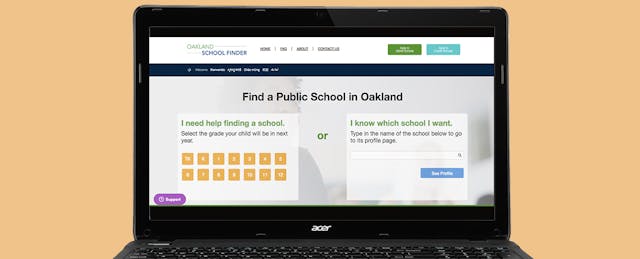School officials and education activists in Oakland, California have teamed up in a notable collaboration to simplify public school enrollment. As a step towards universal enrollment—in which families can fill out one application for district and charter schools alike—Oakland Unified School District (OUSD) and nonprofit Enroll Oakland Charters (EOC) are providing newly unified access to resources and applications for the variety of school choices available, a move that is delighting some while worrying others.
The New “Oakland School Finder”
A key piece of this initiative is The Oakland School Finder, which launched in December. The site provides consolidated information about public and district schools, as well as links to applications for both. Using the School Finder wizard from any device, parents can input their address and select criteria that matter to them in a school, like blended learning, an emphasis on the arts, or after-school programming. The School Finder then generates a map that highlights all of the surrounding schools—both district and charter—that fit the parents’ preferences. With additional detail about each school and direct links to applications, this tool seeks to be a one-stop shop for school enrollment.
Additionally, OUSD and EOC partnered with school choice platform provider SchoolMint to provide a unified application platform. While the applications for district and charter schools are still separate, families only have to create one account and profile that they can use for both. With participation from 90% of Oakland’s charter schools, this platform allows families to complete just one application for charter schools (as opposed to one application for each charter school) and one application for district schools. Not only does the platform support the submission of the applications, but it also facilitates key stakeholder communications. From submitting the application to awaiting varying lotteries to actually completing the requirements to enroll, parents can access all of of this pertinent information at any time from their computer or device.
“Any tools that can help streamline these application processes would be useful for today's households,” says Lisa Schultz, a parent in Oakland who began thinking back in late December about school options for her son. “When both parents tend to be working parents, they lack the downtime they need for the individual applications.”
In addition to time saving, school choice advocates see this move as a critical step towards equity, making it easier for all families to access information about school options and navigate the enrollment process. With a growing number of charter schools in Oakland (now over 40), the landscape has become increasingly tricky to navigate. Historically, each charter school or network had its own application process: unique requirements, timelines, and modes of communication. Some argue that this system put under-resourced families at a disadvantage, as many of them did not have the tools, network, or knowledge to successfully find the best-fit school for their child. But now, with the Oakland School Finder and application platform, families can explore and apply to any of the participating charter schools in one place.
“This isn’t about kids, it’s about charters”
At the same time, the school choice movement has its fair share of opposition.
Anti-charter groups, like OUSD Parents United, oppose a unified application. They claim that streamlining this process and combining the system for district and charter schools increases the likelihood that families will leave OUSD in favor of charter schools, diverting attention and resources from the school district. Some even go as far as saying this enrollment initiative is a “ploy” to help charters capture more market share from a district that already struggles to make ends meet.
These concerns echo broader anti-charter sentiments across the country. Just last month, voters in Massachusetts rejected a bill that would have increased the number of charters allowed across the state. Key opponents of this bill, like Senior Senator Elizabeth Warren, cite a similar argument to what’s being heard in Oakland—specifically, the rapid expansion of charter schools unilaterally hurts the neighboring districts and students.
Oakland is not the first to implement unified enrollment; districts in New Jersey, New Orleans, Denver, Detroit, and Washington, D.C. have also moved towards streamlined applications and enrollment across district and charter schools. Critics point to districts like Newark, which saw dramatic increases in charter enrollment and decreases in district enrollment following the universal enrollment implementation. However, others say that these enrollment numbers are part of a larger trend and are not directly correlated to a new application system.
Applications in Oakland are now live for both district and charter schools for the 2017 - 2018 school year. Only time will tell if OUSD sees a negative impact as a result of this unified system, or if—as advocates hope—all schools and families benefit from this initiative.


